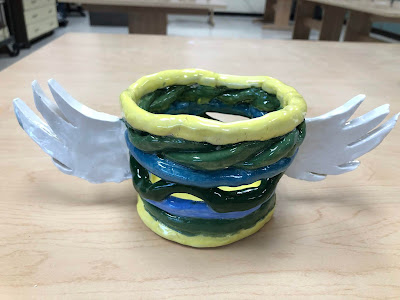Coil pottery From Ancient to Present
A technique of making Pottery by only using hands and simple tools
Students will be able to:
- · Make
a ceramic vessel using coil techniques
- · Decorate
the vessel through additive and subtractive processes
- · Tell
a story on their pot (narrative)
- · Connect
their own coil
pot to other subjects
Culture Aspect:
§ Three Ancient history pottery pictures studies in Geometric symbols
Expression:
§Personal Funds of Knowledge in Geometric Symbols ceramic pottery
Title/Theme/Story:
§Personal Funds of Knowledge in Geometric Symbols ceramic pottery
Title/Theme/Story:
§Creative writing
Creative
Processes:
- · Additive-
using clay
coils to creating the form of the pot by scoring and adding clay and slip
- · Subtractive-
using various
tools (forks, carving tool, popsicle stick, toothpick) to remove clay in order
to create contrast and unique designs
- · Texturize–
marking the surface of the clay in order to create a tactile surface
- · Sculpting_ building and adding a personal meaningful object to the coil vessel
- · Underglazing - using paint brushes and underglaze to apply color to coil pot before firing
- · Glazing- apply glaze on the coil vessel
What is Coil Pottery?
Pottery and ceramic are one of the oldest forms of art. It is also one of the functionals. Pottery was first used to store and preserve food and beverage. It was later used for artistic purposes. Coiled pots are constructed by gradually stacking and joining coils of clay one on top of the other. The coils can be left visible or can be smoothed away depending on your desired aesthetic end result. It is important that the coils join well during construction to avoid cracking or separation during the drying and firing process.History of Pottery
Coiling is a method of creating pottery. It has been used to shape clay into vessels for many thousands of years. It ranges from Africa to Greece and from China to New Mexico. Using the coiling technique, it is possible to build thicker or taller walled vessels, which may not have been possible using earlier methods.
Assignment 1:
Create a research Google slide assignment to answer the following essential questions of Coil Pottery from Ancient to Present Project :
Cover page: Coil Pottery from Ancient to Present+ ClassCode+ First name + Last Name initial
Save the presentation in this title: Coil Pottery+ First name + Last Name initial
Discuss and answer the following questions:
Essential Questions:
1. What are the special qualities of clay that allow it to be both sculptural and functional?
2. What knowledge and basic actions does one need to make a successful piece of creating with clay?
3. How is the kiln involved in pottery production, and how does the clay change after firing?
4. How do artists and designers document the development of their artistic process?
Research
- Why geometric patterns are found in many ancient pottery cultures? List and research 3 geometric pattern pottery from Ancient pottery history which is represented from different cultures.
- Why geometric patterns were created for the Ancient pottery? Please discuss the possible reasons.
- What are the common symbols you have found in ancient Pottery ( draw 3 symbols that you will use to design your coil?? What is the possible meaning?
For examples :
Painted Pottery pot with geometric lattice pattern ( Bachang Type of Majiayao Culture 2200 - 2000 B.C. ) Shanghai Museum of ancient Chinese art China
Endless Possibility
Possible designs of coils:
Exempls:
Coil pottery rubric
1. Planning: Coil pottery from Ancient to Present Worksheets
2. Using coil techniques to build a coiled vessel base: At least 1/2 of the sculptural must use coil technique. 3. Using 3 types of Ancient cultural Pottery symbols in the coiled vessel base: Research 3 symbols and internalize the symbols then use the symbolic patters into your coil pottery making.
3. Decorating the vessel: Students will have used at least one tool to remove clay, and have at least one area where the clay has been added.
4. Building and attaching one or more objects to the coil vessel to convey a meaning.
5. Apply underglaze and glaze - using paintbrushes and underglaze to apply color to coil pot after firing. Apply glaze on the coil vessel.
5. Apply underglaze and glaze - using paintbrushes and underglaze to apply color to coil pot after firing. Apply glaze on the coil vessel.
. 6. Narrative writing: A narrative writing interprets the symbolic meaning of personal storytelling. Develop a big idea for the coil pottery including a title, meaning for the symbols, a theme.
8. Taking a picture from different clay stages
Greenware:
Bisqueware:
Bisqueware painted with the underglaze
Glazeware:
Example: Diamond Art Teacher- Ms. Alexander
How to Make a Coil Pot:
1. Make slab of clay with rolling pin
2. Cut a slab base - 1/4" thick
3. Make coils by hand or extruder
4. Score and slip base and apply coil
5. Cut coils as illustrated
6. Pinch coil into slab on the inside
7. Repeat the steps to build up the coils
8. Add different design of coils that were inspired by ancient geometric symbols research
Possible designs of coils:
Examples:
Create a final artwork of coil pottery from Ancient to Present slide assignment including the following aspects:
- 5 pictures of final artwork coil pottery: front view, side view, inside and bottom view including a title
- 5 pictures of symbols used including meanings
- Narrative writing of big idea/ personal story
- References






























































